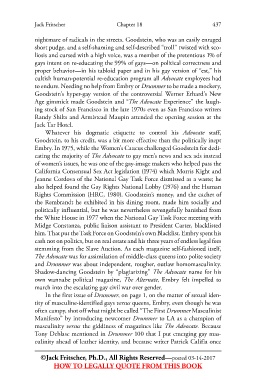Page 455 - Gay Pioneers: How DRUMMER Magazine Shaped Gay Popular Culture 1965-1999
P. 455
Jack Fritscher Chapter 18 437
nightmare of radicals in the streets. Goodstein, who was an easily enraged
short pudge, and a self-shaming and self-described “troll” twisted with sco-
liosis and cursed with a high voice, was a member of the pretentious 1% of
gays intent on re-educating the 99% of gays—on political correctness and
proper behavior—in his tabloid paper and in his gay version of “est,” his
cultish human-potential re-education program all Advocate employees had
to endure. Needing no help from Embry or Drummer to be made a mockery,
Goodstein’s hyper-gay version of the controversial Werner Erhard’s New
Age gimmick made Goodstein and “The Advocate Experience” the laugh-
ing stock of San Francisco in the late 1970s even as San Francisco writers
Randy Shilts and Armistead Maupin attended the opening session at the
Jack Tar Hotel.
Whatever his dogmatic etiquette to control his Advocate staff,
Goodstein, to his credit, was a bit more effective than the politically inept
Embry. In 1975, while the Women’s Caucus challenged Goodstein for dedi-
cating the majority of The Advocate to gay men’s news and sex ads instead
of women’s issues, he was one of the gay-image makers who helped pass the
California Consensual Sex Act legislation (1974) which Morris Kight and
Jeanne Cordova of the National Gay Task Force dismissed as a waste; he
also helped found the Gay Rights National Lobby (1976) and the Human
Rights Commission (HRC, 1980). Goodstein’s money, and the cachet of
the Rembrandt he exhibited in his dining room, made him socially and
politically influential, but he was nevertheless revengefully banished from
the White House in 1977 when the National Gay Task Force meeting with
Midge Constanza, public liaison assistant to President Carter, blacklisted
him. That put the Task Force on Goodstein’s own Blacklist. Embry spent his
cash not on politics, but on real estate and his three years of endless legal fees
stemming from the Slave Auction. As each magazine self-fashioned itself,
The Advocate was for assimilation of middle-class queens into polite society
and Drummer was about independent, rougher, outlaw homomasculinity.
Shadow-dancing Goodstein by “plagiarizing” The Advocate name for his
own wannabe political magazine, The Alternate, Embry felt impelled to
march into the escalating gay civil war over gender.
In the first issue of Drummer, on page 1, on the matter of sexual iden-
tity of masculine-identified gays versus queens, Embry, even though he was
often campy, shot off what might be called “The First Drummer Masculinist
Manifesto” by introducing newcomer Drummer to LA as a champion of
masculinity versus the giddiness of magazines like The Advocate. Because
Tony Deblase mentioned in Drummer 100 that I put emerging gay mas-
culinity ahead of leather identity, and because writer Patrick Califia once
©Jack Fritscher, Ph.D., All Rights Reserved—posted 03-14-2017
HOW TO LEGALLY QUOTE FROM THIS BOOK

